Microstructural Characterization of S355J2 Steel Plate Cut with Plasma in Water-Bed
Abstract
1. Introduction
2. Materials and Experimental Set-Up
2.1. Water Injection Gun and Water-Bed Design
- a.
- The desired precision;
- b.
- The thickness and composition of the material to be cut;
- c.
- Geometric shape;
- d.
- Desired quality;
- e.
- The number of pieces per series;
- f.
- Pollution limit;
- g.
- Considering that plasma cutting, due to the new achievements of traditional companies, is getting closer to laser cutting at a lower price and a comparable quality, the final decision will be made taking into account the savings achieved;
- h.
- The cost of maintenance operations after purchase.
- The motor fan with snail casing (cyclone) for creating depression at the suction mouth;
- The device or devices for filtering the absorbed smoke;
- The absorption device connected through an air duct to the motor fan.
- The use of a specialized device, such as a cutting table, which, with the help of a layer of water, ensures the absorption of the generated microscopic particles suspended in air and, at the same time, faster cooling of the cut base material. Figure 2 illustrates the cutting table.

2.2. Research Logistics
- Cutting path length: 6000 [mm];
- Cutting width: 2200 [mm];
- Thickness of the sheet to be cut: oxy-gas min. 8, max. 120 [mm]; plasma min. 1, max. 30 [mm];
- Positioning speed: 10,000 [mm/min];
- Continuously adjustable cutting speed: yes;
- Cutting path tracking accuracy: 0.1 [mm].
- Straight line cutting in coordinates;
- Automatic alignment of the cutting head with respect to the material to be cut;
- Automatic rotation of the cut piece on the Ox and Oy axes;
- Automatic cutting of mirrored parts and parts to scale;
- Library of standard and derived figures;
- Self-diagnostic messages;
- Return to the cutting contour;
- Automatic return to perforation points or to the interruption point of a program;
- Selection of cutting mode/program run (manual, automatic, step-by-step test);
- Cutting gap compensation.
- Oxy-fuel burner model: Messer Grisheim; or
- Plasma source: with air connected to the compressed air network of the workshop;
- Plasma cutting torch fixed on the cutting arm of the machine;
- Cutting electrode;
- Cutting nozzle: Ø1.6/90–120 Amperes;
- High-resolution field emission scanning electron microscope equipped with energy dispersive X-ray analysis (EDS) system;
- Wilson-Wolpert micro durometer, with loads of 0.01–1 kgf.
- A longer operating life;
- An ecological working environment.
2.3. Experimental Procedure: Analysis of Samples
- Compactness defects (cuts, porosities, cracks);
- Structural inhomogeneities (crystalline grains of different sizes, shapes or orientations, etc.);
- Chemical inhomogeneities (segregation of alloying elements, harmful impurities, etc.);
- Inhomogeneities (areas or layers of different materials joined by gluing, welding or plating, deposited electrolytically, etc.);
- Other material or processing defects (coarse non-metallic inclusions, overlaps, decarburization, etc.), as well as aspects of degradation during service (rupture, wear, corrosion, burning, etc.).
3. Results
- a.
- Samples 1-1 and 1-2—by thermal cutting with air plasma, in the free atmosphere (open air) of the workshop;
- b.
- Samples 2-1 and 2-2—by thermal cutting with air plasma, the piece being placed on a water-bed at the bottom;
- c.
- Samples 3-1 and 3-2—by oxygen flame cutting.
3.1. Samples 1-1 and 1-2
- a.
- The microstructure of the base material, unaffected by the cutting operations, is typical for an unalloyed steel, with a low carbon content, in a plastically deformed + annealed state: equiaxed grains of ferrite and small amounts of pearlite, as seen in Figure 8. The granulation is extremely fine and uniform (average grain diameter 15–16 µm, corresponding to a score of 9 according to ASTM E112). Rarely, non-metallic inclusions (sulfides and silicates) were observed, normal for a steel processed under ordinary conditions. The hardness, determined by the Vickers method with micro loads, was 120–125 HV05.
- b.
- EDS analysis is used for the chemical characterization of each sample and can also highlight precipitation phenomena, which is the reason for applying this method to the characterization of cut surfaces, as seen in Figure 9.
3.2. Samples 2-1 and 2-2
- a.
- The base material presents an absolutely identical structure, probably coming from the same batch: very fine grains of ferrite, equiaxes, and very small amounts of lamellar pearlite, as seen in Figure 11. The hardness confirms the material brand and the heat treatment state, being 120–125 HV05.
- b.
- The modification of the microstructure in the areas thermally affected by cutting is also similar to that observed on the previous samples: partial recrystallization, with the appearance of grains even finer than those of the base material, as well as grain growth to a depth of 100 µm on the edges, in some places even with a martensitic appearance, in the areas where the temperature was higher. A special aspect was observed on sample 2-2, marginally more severely affected, by the appearance of areas of intergranular oxidation and local melting, at a depth of 60–70 µm.
- c.
- The hardness is different, however, with the heat-affected areas registering higher values (230–260 HV05), probably due to the higher cooling rate. See Table 4. Due to the fact that this steel is used for welded structures and the carbon is below 0.2%, it is difficult to harden to martensite, as depicted below. But, the HAZ can reach values of 260 for HV05. See Figure 12 and Figure 13.
3.3. Samples 3-1 and 3-2
- a.
- The base material presents a slightly different structure compared to the samples described previously. Although the structure is still ferrite–pearlitic, a higher amount of pearlite was observed in the ferritic matrix. This may be due to a higher carbon content. Being a surface cutting operation, the transformation of ferrite into pearlite occurs through carbon precipitation but does not reach the parameters for the formation of martensite. The hardness in the core is also slightly higher, around 150–160 HV05. The content of non-metallic inclusions, distributed along the direction of plastic deformation of the material, is also higher.
- b.
- Oxygen flame cutting generated thermal damage to the material at much greater depths: 2 mm on sample 3-1 and 4–5 mm on sample 3-2. The heat-affected zones are visible even macroscopically on the samples attacked with Nital 2%. Marginally, the structure is even martensitic, with large grains, reaching sizes of 200 µm, with coarse platelets that gradually decrease in size, until the core. Also marginally, plastic deformations of the material were observed, forming areas with a strictly local fiber structure.
- c.
3.4. Results Overview
4. Conclusions
Author Contributions
Funding
Institutional Review Board Statement
Informed Consent Statement
Data Availability Statement
Conflicts of Interest
References
- Igwemezie, V.; Shamir, M.; Mehmanparast, A.; Ganguly, S. A review of LTT welding alloys for structural steels: Design, application and results. J. Adv. Join. Process. 2022, 5, 100110. [Google Scholar] [CrossRef]
- Cheng, C.; Xie, X.; Yu, M.; Wang, T. A CDM-based constitutive model for structural steel considering ULCF damage accumulation. J. Constr. Steel Res. 2025, 232, 109646. [Google Scholar] [CrossRef]
- Xu, F.; Zhao, J.; Zhou, X.; Yun, X.; Liu, J.-Z.; Okazaki, T. Long-term strain ageing effects on low-carbon structural steels. J. Constr. Steel Res. 2025, 231, 109579. [Google Scholar] [CrossRef]
- Uszball, S.; Knobloch, M. Post-fire structural material behaviour of high- and ultra-high-strength steels–Experimental study and aids for assessment for further use and potential reuse after fires. Constr. Build. Mater. 2024, 443, 137742. [Google Scholar] [CrossRef]
- Klusák, J.; Seitl, S. Very high cycle fatigue tests of high strength steels S355 J0 and S355 J2. Procedia Struct. Integr. 2019, 17, 576–581. [Google Scholar] [CrossRef]
- Ferreño, D.; Portilla Carral, J.; Lacalle Calderón, R.; Álvarez, J.A.; Gutiérrez-Solana, F. Development and experimental validation of a simplified Finite Element methodology to simulate the response of steel beams subjected to flame straightening. Constr. Build. Mater. 2017, 137, 535–547. [Google Scholar] [CrossRef]
- Cortés, R.; Garrido, M.A.; Rico, A.; Múnez, C.J.; Poza, P.; Martos, A.M.; Dosta, S.; Cano, I.G. Effect of processing conditions on the mechanical performance of stainless steel cold sprayed coatings. Surf. Coat. Technol. 2020, 394, 125874. [Google Scholar] [CrossRef]
- Das, R.; Sivaswamy, G.; Lalvani, H.; Singh, A.P. Fracture toughness and microstructural analysis of rotary friction welded S355J2 and SS316L steels for critical applications. J. Adv. Join. Process. 2024, 10, 100244. [Google Scholar] [CrossRef]
- Graebner¨, M.; Giese, M.; Lorenz, S.; Treutler, K.; Schroepfer¨, D.; Wesling, V.; Kannengiesser, T. Wear resistance of modified NiMoCrSi claddings in relation to the resulting surface machinability via ultrasonic-assisted milling. Wear 2025, 571, 205830. [Google Scholar] [CrossRef]
- Bendikiene, R.; Ciuplys, A.; Sertvytis, R.; Surzhenkov, A.; Tkachivskyi, D.; Viljus, M.; Traksmaa, R.; Antonov, M.; Kulu, P. Wear behaviour of Cr3C2–Ni cermet reinforced hardfacings. J. Mater. Res. Technol. 2020, 9, 7068–7078. [Google Scholar] [CrossRef]
- Milz, M.P.; Wirtz, A.; Abdulgader, M.; Biermann, D.; Tillmann, W.; Walther, F. Influence of twin wire arc spraying and machine hammer peening on the corrosion fatigue of ZnAl4 coatings on S355 J2C + C substrate. Procedia Struct. Integr. 2022, 42, 830–837. [Google Scholar] [CrossRef]
- Zorc, B.; Bernetič, J.; Nagode, A. Effects of welding residual stresses and phosphorus segregation on cleavage delamination fracture in thick S355 J2 G3+N steel plate. Eng. Fail. Anal. 2014, 40, 8–14. [Google Scholar] [CrossRef]
- Ulewicz, R.; Szataniak, P.; Novy, F.; Trsko, L.; Bokuvka, O. Fatigue characteristics of structural steels in the gigacycle region of loading. Mater. Today Proc. 2017, 4, 5979–5984. [Google Scholar] [CrossRef]
- Stranghöner, N.; Jungbluth, D. Fatigue Strength of Marked Steel Components. Procedia Eng. 2015, 133, 282–293. [Google Scholar] [CrossRef][Green Version]
- Straße, A.; Üstündağ, Ö.; Gumenyuk, A.; Rethmeier, M. LMD coatings as filler material for laser beam welded 30 mm thick plates. Procedia CIRP 2020, 94, 293–297. [Google Scholar] [CrossRef]
- Wang, J.; Wong, W.C.K. A study of abrasive waterjet cutting of metallic coated sheet steels. Int. J. Mach. Tools Manuf. 1999, 39, 855–870. [Google Scholar] [CrossRef]
- Irsel, G.; Güzey, B.N. Comparison of laser beam, oxygen and plasma arc cutting methods in terms of their advantages and disadvantages in cutting structural steels. J. Phys. Conf. Ser. 2021, 2130, 012022. [Google Scholar] [CrossRef]
- Harničárová, M.; Valíček, J.; Zajac, J.; Hloch, S.; Čep, R.; Džubáková, I.; Tofil, S.; Hlaváček, P.; Klich, J.; Čepová, L.; et al. Techno-economical comparison of cutting material by laser, plasma and oxygen. Ekon. Usporedba Rezanja Mater. Pomoću Lasera Plazme i Kisika 2012, 19, 813–817. Available online: https://core.ac.uk/download/pdf/10672942.pdf (accessed on 1 June 2025).
- Jagadish; Gupta, K. Abrasive Water Jet Machining of Engineering Materials; Springer International Publishing: Berlin/Heidelberg, Germany, 2020. [Google Scholar] [CrossRef]
- Gullu, A.; Atici, U. Investigation of the effects of plasma arc parameters on the structure variation of AISI 304 and St 52 steels. Mater. Des. 2006, 27, 1157–1162. [Google Scholar] [CrossRef]
- Jiang, X.-Y.; Hu, J.; Jiang, S.-L.; Wang, X.; Zhang, L.-B.; Li, Q.; Lu, H.-P.; Yin, L.-J.; Xie, J.-L.; Deng, L.-J. Effect of high-enthalpy atmospheric plasma spraying parameters on the mechanical and wear resistant properties of alumina ceramic coatings. Surf. Coat. Technol. 2021, 418, 127193. [Google Scholar] [CrossRef]
- Luțcanu, M.; Cimpoeșu, N.; Istrate, B.; Coteață, M.; Manole, V.; Știrbu, I.; Dimitriu, F. Analyze of Cutting Effect on Ceramic Coated Steels. Procedia Manuf. 2020, 47, 808–811. [Google Scholar] [CrossRef]
- Luțcanu, M.; Coteață, M.; Bernevig, M.A.; Nechifor, C.D.; Cazacu, M.M.; Paraschiv, P.; Istrate, B.; Bădărău, G.; Sandu, I.G.; Cimpoeșu, N. Obtaining and Analyzing the Al2O3-ZrO2 Ceramic Layers on Metallic Substrate. Arch. Metall. Mater. 2021, 479–485. [Google Scholar] [CrossRef]
- Krajcarz, D. Comparison Metal Water Jet Cutting with Laser and Plasma Cutting. Procedia Eng. 2014, 69, 838–843. [Google Scholar] [CrossRef]
- Akkurt, A. Surface properties of the cut face obtained by different cutting methods from AISI 304 stainless steel materials. Indian J. Eng. Mater. Sci. 2009, 16, 373–384. Available online: https://nopr.niscpr.res.in/bitstream/123456789/7293/1/IJEMS%2016(6)%20373-384.pdf (accessed on 2 June 2025).
- Olah, A.; Machedon-Pisu, M.; Machedon-Pisu, T. Research on Mechanized Plasma Gouging of Weldable Construction Steels. Coatings 2024, 14, 1502. [Google Scholar] [CrossRef]
- Bhuvenesh, R.; Abdul Manan, M.S.; Norizaman, M.H. The Study of Surface Roughness and MRR of Mild Steel Using Manual Plasma Arc Cutting Machining. Adv. Mater. Res. 2012, 576, 3–6. [Google Scholar] [CrossRef]
- Bini, R.; Colosimo, B.M.; Kutlu, A.E.; Monno, M. Experimental study of the features of the kerf generated by a 200A high tolerance plasma arc cutting system. J. Mater. Process. Technol. 2008, 196, 345–355. [Google Scholar] [CrossRef]
- Colombo, V.; Concetti, A.; Ghedini, E.; Rotundo, F.; Sanibondi, P.; Boselli, M.; Dallavalle, S.; Gherardi, M.; Nemchinsky, V.; Vancini, M. Advances in Plasma Arc Cutting Technology: The Experimental Part of an Integrated Approach. Plasma Chem. Plasma Process. 2012, 32, 411–426. [Google Scholar] [CrossRef]
- Colombo, V.; Concetti, A.; Ghedini, E.; Dallavalle, S.; Fazzioli, R.; Vancini, M. Optimization of plasma arc cutting of mild steel thin plates. In Proceedings of the 2008 IEEE 35th International Conference on Plasma Science, Karlsruhe, Germany, 15–19 June 2008. [Google Scholar] [CrossRef]
- Nemchinsky, V.A. Two phases of droplet evaporation during plasma arc spraying: Reply to Chen’s comment about the ‘rocket’ effect under conditions of thermal plasma spraying. J. Phys. D Appl. Phys. 2007, 40, 4098–4100. [Google Scholar] [CrossRef]
- Ramakrishnan, S.; Shrinet, V.; Polivka, F.B.; Kearney, T.N.; Koltun, P. Influence of gas composition on plasma arc cutting of mild steel. J. Phys. D Appl. Phys. 2000, 33, 2288–2299. [Google Scholar] [CrossRef]
- Sember, V.; Mašláni, A.; Křenek, P.; Heinrich, M.; Nimmervoll, R.; Pauser, H.; Hrabovský, M. Spectroscopic Characterization of a Steam Arc Cutting Torch. Plasma Chem. Plasma Process. 2011, 31, 755–770. [Google Scholar] [CrossRef]
- Ebadian, M.A.; Dua, S.K.; Guha, H. Size Distribution and Rate of Production of Airborne Particulate Matter Generated During Metal Cutting; Hemispheric Center for Environmental Technology: Pittsburgh, PA, USA, 2001. [CrossRef][Green Version]
- Zhou, Q.; Li, H.; Liu, F.; Guo, S.; Guo, W.; Xu, P. Effects of Nozzle Length and Process Parameters on Highly Constricted Oxygen Plasma Cutting Arc. Plasma Chem. Plasma Process. 2008, 28, 729–747. [Google Scholar] [CrossRef]
- Pandya, D.M. A Review Paper on Study and optimization of Process Parameter in Plasma arc Cutting. Int. J. Res. Appl. Sci. Eng. Technol. 2019, 7, 537–542. [Google Scholar] [CrossRef]
- Rzeźnikiewicz, A. Cost comparison between oxyfuel and plasma cutting low alloy steel. J. Achiev. Mater. Manuf. Eng. 2014, 63, 81–85. Available online: http://jamme.acmsse.h2.pl/vol63_2/6324.pdf (accessed on 3 June 2025).
- Sharma, A.; Yadava, V. Experimental analysis of Nd-YAG laser cutting of sheet materials–A review. Opt. Laser Technol. 2018, 98, 264–280. [Google Scholar] [CrossRef]
- Kanyilmaz, A. The problematic nature of steel hollow section joint fabrication, and a remedy using laser cutting technology: A review of research, applications, opportunities. Eng. Struct. 2019, 183, 1027–1048. [Google Scholar] [CrossRef]
- He, Y.; Xie, H.; Ge, Y.; Lin, Y.; Yao, Z.; Wang, B.; Jin, M.; Liu, J.; Chen, X.; Sun, Y. Laser Cutting Technologies and Corresponding Pollution Control Strategy. Processes 2022, 10, 732. [Google Scholar] [CrossRef]
- Akkurt, A. The effect of cutting process on surface microstructure and hardness of pure and Al 6061 aluminium alloy. Eng. Sci. Technol. Int. J. 2015, 18, 303–308. [Google Scholar] [CrossRef]
- Majolagbe, S.; Abioye, A.; Akinluwade, K.; Adesina, O.; Adetunji, A. Radiation Effects: Recommendations for Safe Plasma/Flame Cutting Operation. J. Sci. Res. Rep. 2015, 6, 237–242. [Google Scholar] [CrossRef]
- Radovanovic, M. Abrasive Waterjet Cutting Cost. Nonconventional Technologies Review. No.1. Available online: https://www.academia.edu/39248632/Nonconventional_Technologies_Review_No_1_2007_97_ABRASIVE_WATERJET_CUTTING_COST (accessed on 4 June 2025).
- Aloke, R.; Girish, V.; Scrutton, R.F.; Molian, P.A. A model for prediction of dimensional tolerances of laser cut holes in mild steel thin plates. Int. J. Mach. Tools Manuf. 1997, 37, 1069–1078. [Google Scholar] [CrossRef]
- Luţcanu, M.; Munteanu, C.; Kicsi, G.; Roman, A.-M.; Croitoru, C.G.; Prisecariu, B.A.; Cazacu, M.M.; Ştirbu, I.; Chicet, D.L.; Cimpoeşu, N. Analysis of water jet cutting of metal-ceramic elements made through atmospheric plasma spraying technique. Mater. Today Proc. 2023, 72, 550–553. [Google Scholar] [CrossRef]
- Lutcanu, M.; Istrate, B.; Coteata, M.; Chicet, D.L.; Ionita, I.; Paraschiv, C.; Stirbu, I.; Badarau, G.; Cimpoesu, N. Structural aspects and chemical analyses on cutting process of metallic-ceramic materials. IOP Conf. Ser. Mater. Sci. Eng. 2021, 1037, 012033. [Google Scholar] [CrossRef]
- Mitchell, B.R.; Demian, S.A.R.; Korkolis, Y.P.; Kinsey, B.L. Experimental comparison of material removal rates in abrasive waterjet cutting and a novel droplet stream technique. Procedia Manuf. 2020, 48, 586–592. [Google Scholar] [CrossRef]
- Hlaváčová, I.M.; Sadílek, M.; Váňová, P.; Szumilo, Š.; Tyč, M. Influence of steel structure on machinability by abrasive water jet. Materials 2020, 13, 4424. [Google Scholar] [CrossRef]
- Natarajan, Y.; Murugesan, P.K.; Mohan, M.; Liyakath Ali Khan, S.A. Abrasive Water Jet Machining process: A state of art of review. J. Manuf. Process. 2020, 49, 271–322. [Google Scholar] [CrossRef]
- Ivan, P.; Dejan, M.; Bogdan, N.; Ivan, S. Modeling and Optimization of Cut Quality Responses in Plasma Jet Cutting of Aluminium Alloy EN AW-5083. Materials 2021, 14, 5559. [Google Scholar] [CrossRef] [PubMed]
- SR EN 10025/25-2004; Standard for Rolled Steels EN 10025-2. Asociația de Standardizare din România (ASRO): Bucharest, Romania, 2004.

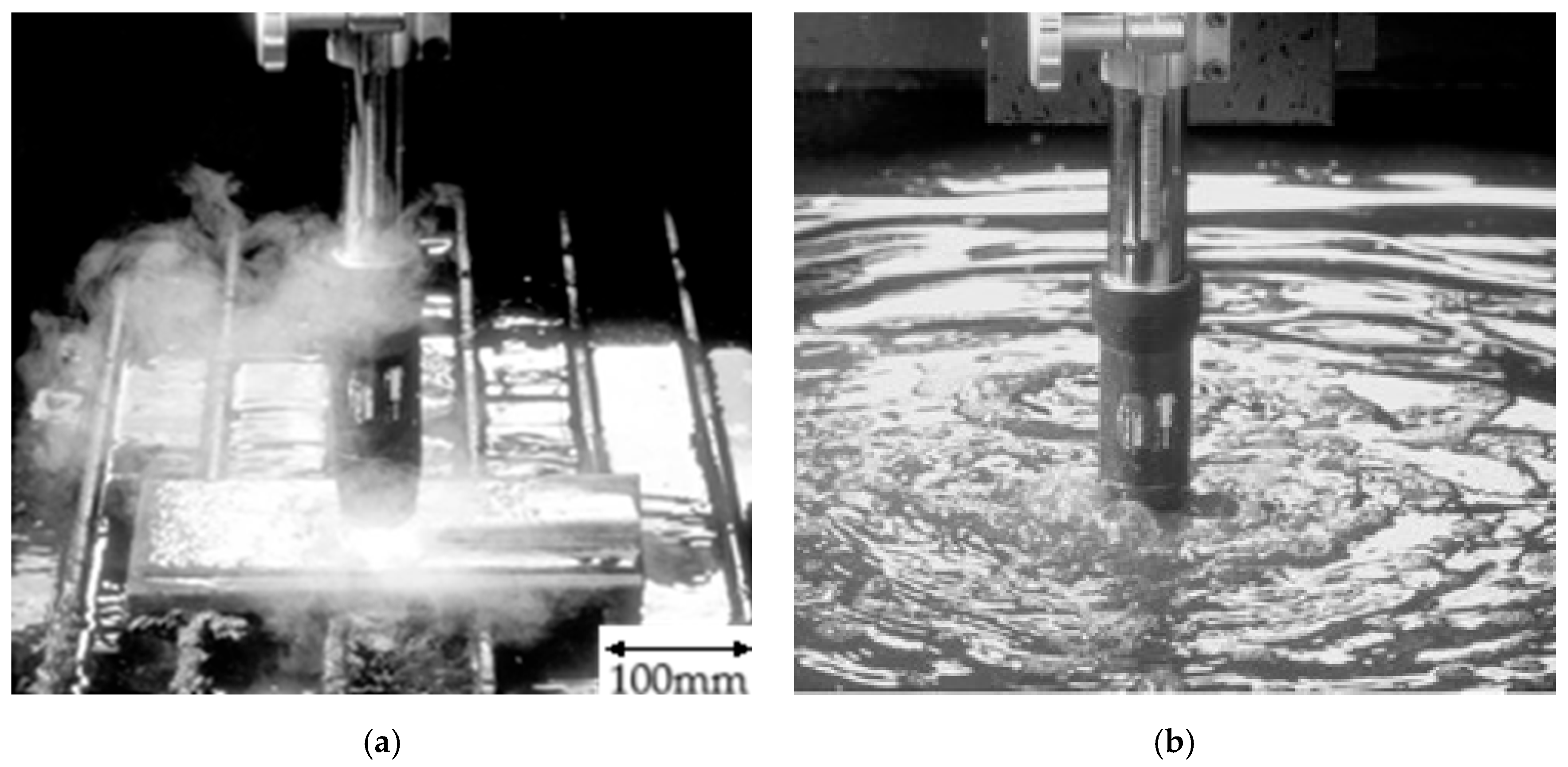


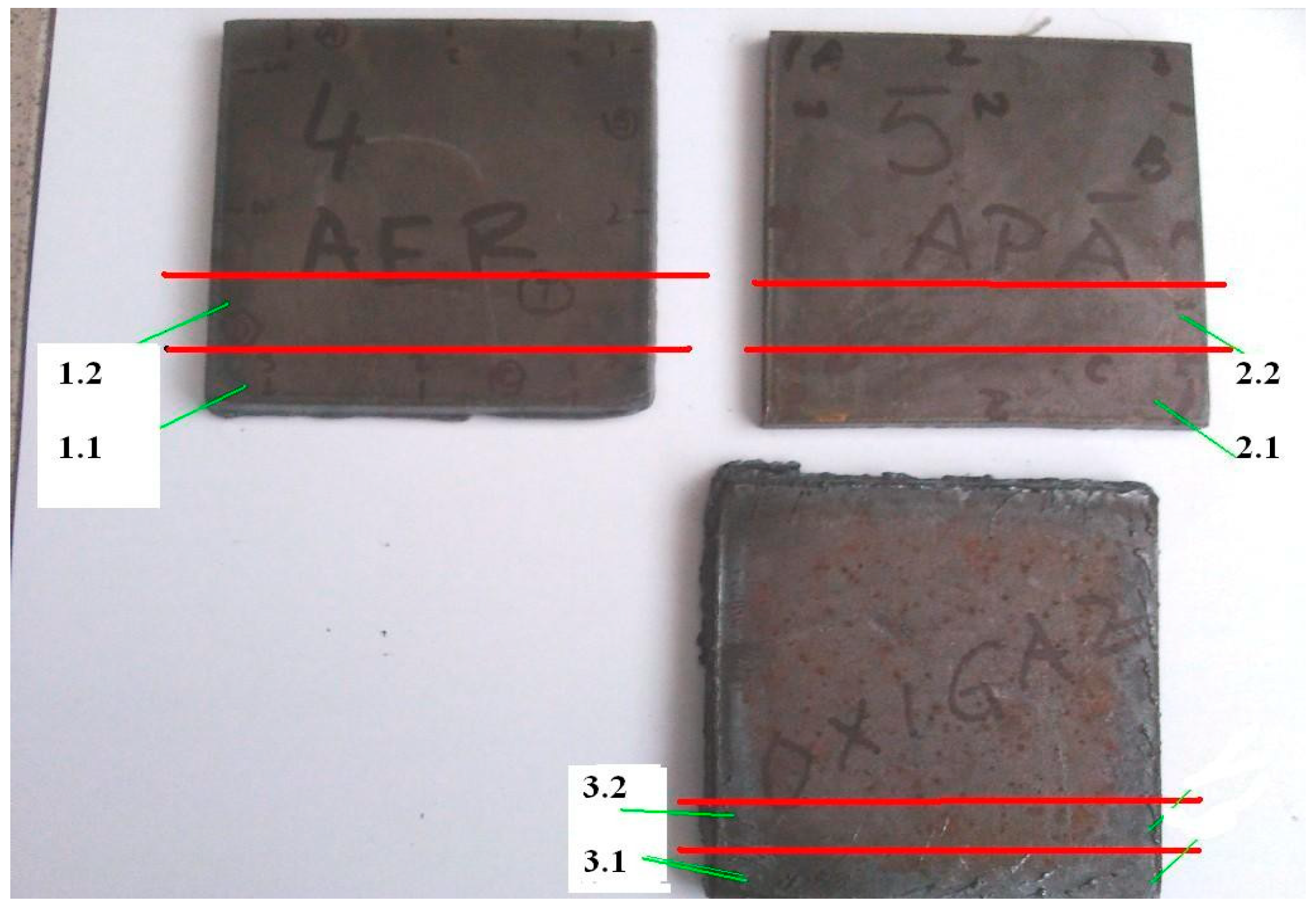



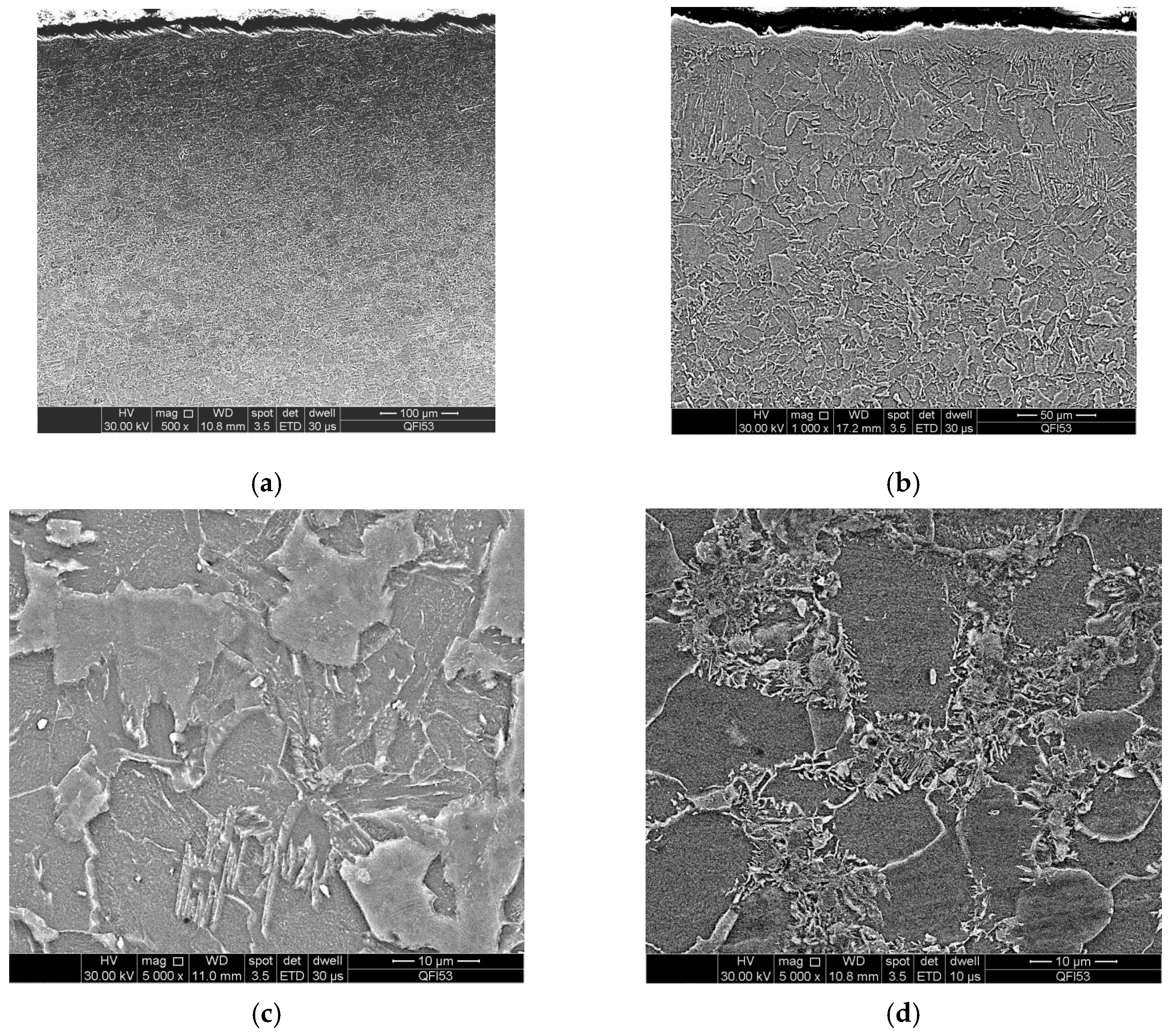
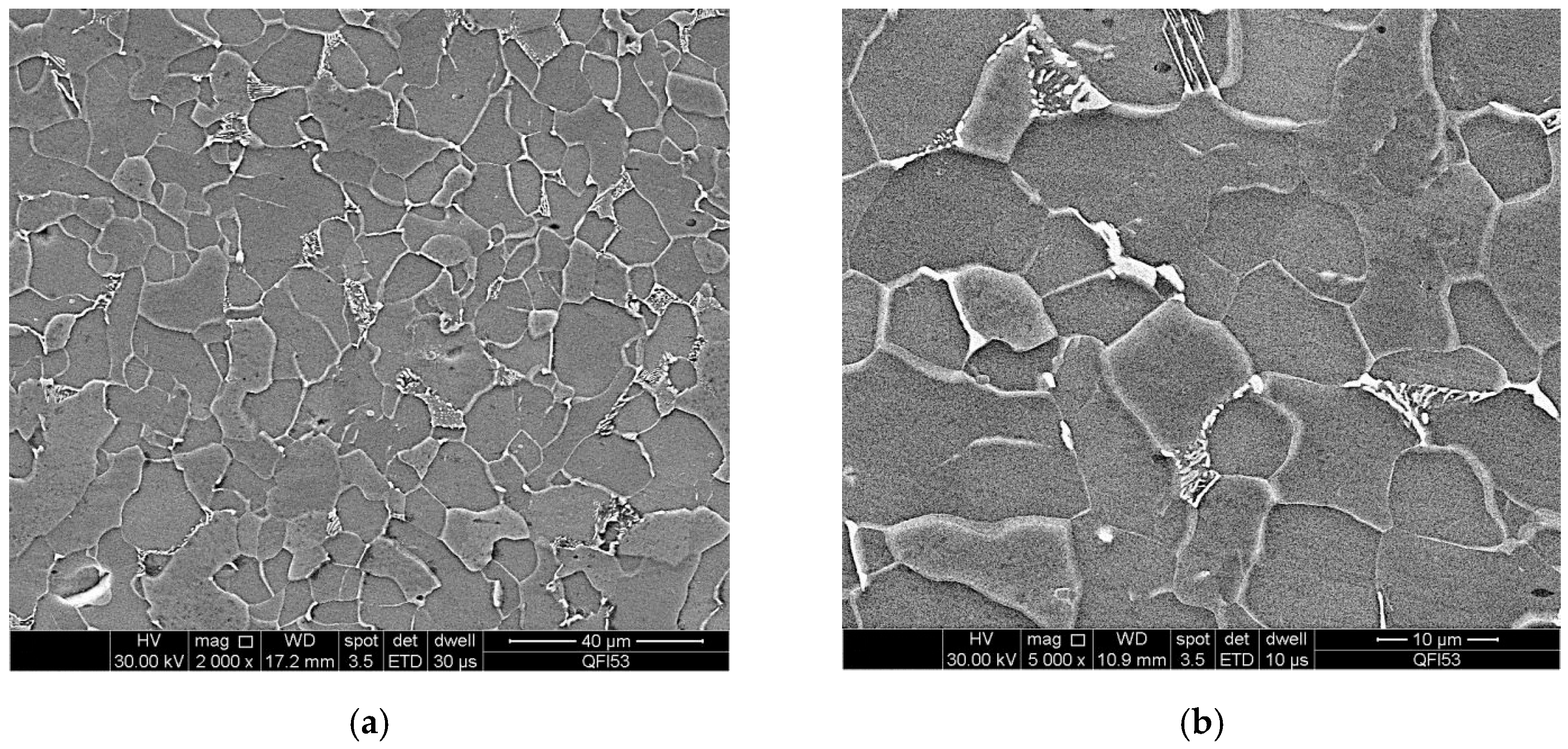
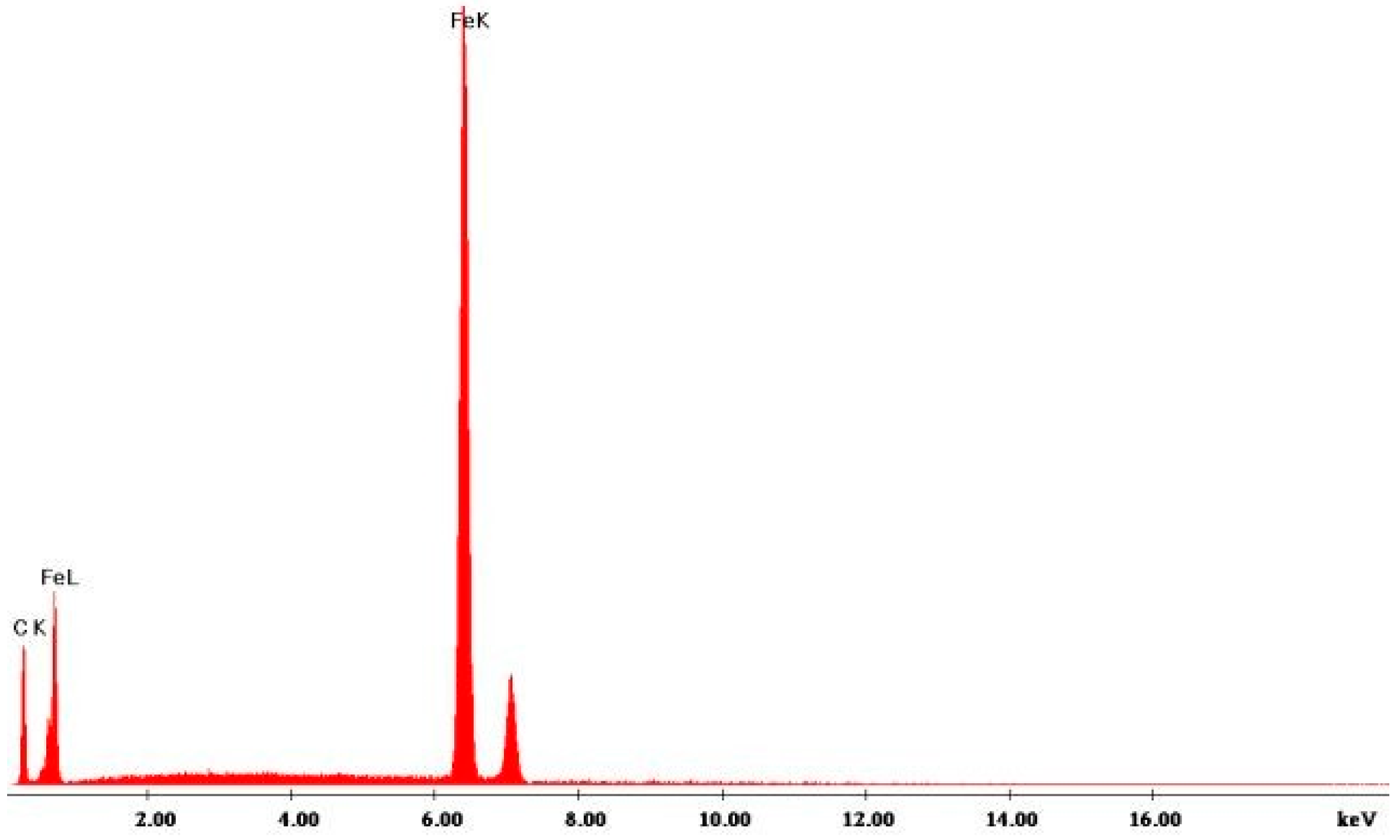


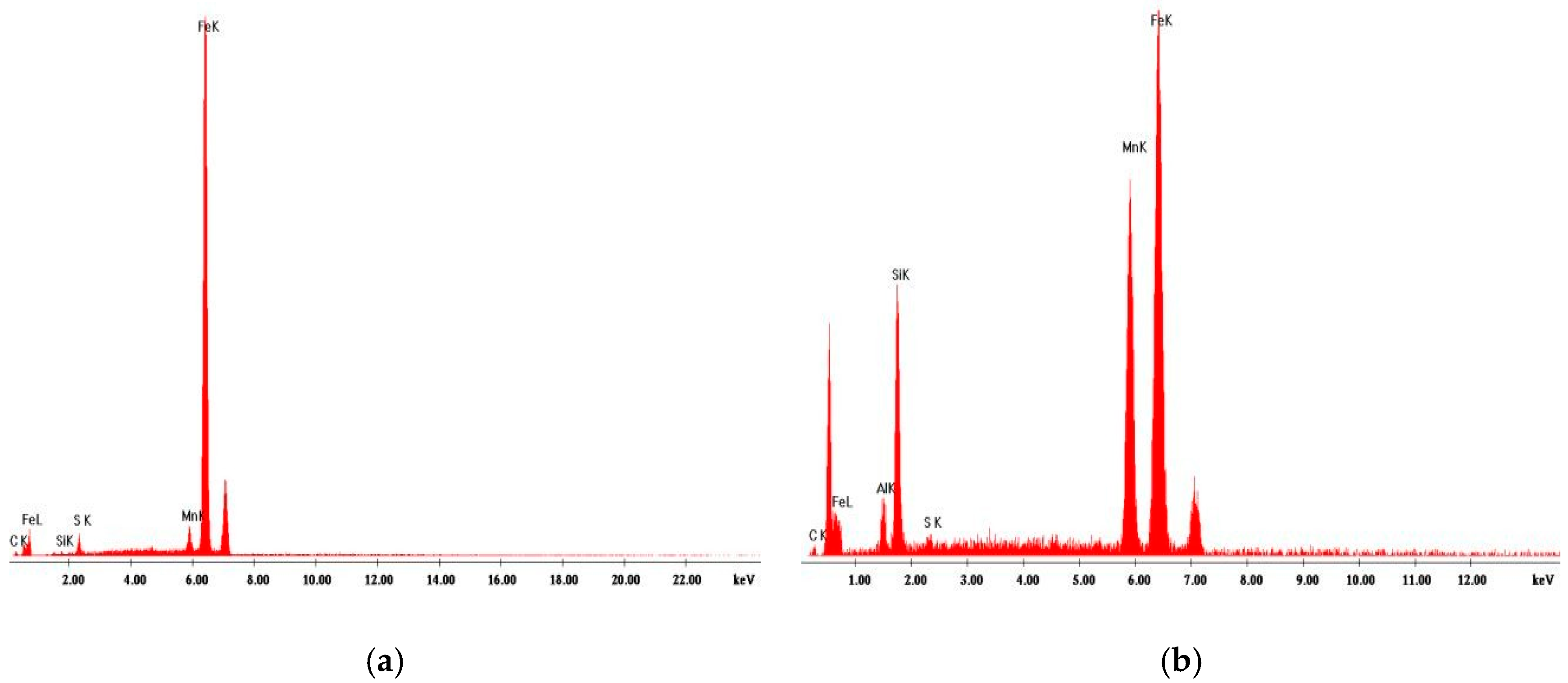
| C | Mn | Si | Cu | P | S | Al | As | Ti |
| 0.0155 | 1.42 | 0.18 | 0.015 | 0.018 | 0.01 | 0.037 | 0.05 | 0.001 |
| V | Ni | Cr | Mo | Nb | B | N2 | Ca | Fe |
| 0.001 | 0.01 | 0.01 | 0.001 | 0.001 | 0.0001 | 0.008 | 0.0001 | Balance |
| Parameter | Value |
|---|---|
| Cutting speed | 1000 mm/min |
| Torch/base material distance | 5 mm |
| Cutting current intensity | 100 A |
| Plasma air pressure | 6 Bar |
| Cooling water volume | 20 L |
| Initial water temperature | 19.10 °C |
| Final water temperature | 69.40 °C |
| Cutting time | 4 min 23 s |
| Depth [mm] | Sample 1-1 [HV05 Value] | Sample 1-2 [HV05 Value] |
|---|---|---|
| 0.1 | 172 | 171 |
| 0.2 | 164 | 173 |
| 0.3 | 165 | 175 |
| 0.4 | 163 | 168 |
| 0.5 | 160 | 161 |
| 0.6 | 165 | 157 |
| 0.7 | 160 | 147 |
| 2 | 121 | 121 |
| Depth [mm] | Sample 2-1 [HV05 Value] | Sample 2-2 [HV05 Value] |
|---|---|---|
| 0.1 | 233 | 258 |
| 0.2 | 225 | 237 |
| 0.3 | 200 | 220 |
| 0.4 | 189 | 188 |
| 0.5 | 172 | 175 |
| 0.6 | 175 | 170 |
| 0.7 | 171 | 172 |
| 2 | 124 | 126 |
| Depth [mm] | Sample 3-1 [HV05 Value] | Sample 3-2 [HV05 Value] |
|---|---|---|
| 0.1 | 223 | 255 |
| 0.2 | 226 | 210 |
| 0.3 | 195 | 217 |
| 0.4 | 190 | 202 |
| 0.5 | 188 | 197 |
| 0.6 | 180 | 200 |
| 0.7 | 182 | 192 |
| 1 | 177 | 190 |
| 1.3 | 176 | 181 |
| 1.5 | 173 | 172 |
| 5 | 144 | 152 |
| Determinations Performed | Samples Cut with Plasma in Open Air | Samples Cut with Plasma in Water-Bed | Samples Cut with Oxygen Flame |
|---|---|---|---|
| (1) Measurements of nominal dimensions after cutting | Lower dimensional accuracy | Higher dimensional accuracy | Measurements were not carried out due to the very low quality of the cut parts |
| (2) Angular deviation of the cut edge | More pronounced, max 11° side | Lower, max 8° side | |
| (3) Circularity deviation | Present | Present, but reduced by half | |
| Macroscopic analysis | |||
| (1) Depth of scratches | More pronounced | Lower | Measurements were not carried out due to the very low quality of the cut edge |
| (2) Slag | At bottom | At bottom, in a reduced amount | |
| Microscopic analysis | |||
| (1) Base material zone | Equiaxed ferrite grains (size 15–16 µm) and small amounts of pearlite | Equiaxed ferrite grains (size 15–16 µm) and small amounts of pearlite | Although the structure is still ferrite-pearlitic, a greater amount of pearlite was observed in the ferritic matrix. |
| (2) HAZ | 01–0.7 mm with transformations in the austenitic temperature zone | 01–0.7 mm, with transformations in the austenitic temperature zone and intergranular oxidation zones due to the water-bed | Extended: 4–5 mm, with martensitic structure and large grains; shows marginal elastic deformations |
| (1) Microhardness in Base material zone | 125–120 HV05 | 125–120 HV05 | 160–150 HV05 |
| (2) Microhardness in HAZ | 172–147 HV05 | 260–172 HV05 | 255–144 HV05 |
Disclaimer/Publisher’s Note: The statements, opinions and data contained in all publications are solely those of the individual author(s) and contributor(s) and not of MDPI and/or the editor(s). MDPI and/or the editor(s) disclaim responsibility for any injury to people or property resulting from any ideas, methods, instructions or products referred to in the content. |
© 2025 by the authors. Licensee MDPI, Basel, Switzerland. This article is an open access article distributed under the terms and conditions of the Creative Commons Attribution (CC BY) license (https://creativecommons.org/licenses/by/4.0/).
Share and Cite
Machedon-Pisu, T.; Machedon-Pisu, M.; Olah, A. Microstructural Characterization of S355J2 Steel Plate Cut with Plasma in Water-Bed. Coatings 2025, 15, 866. https://doi.org/10.3390/coatings15080866
Machedon-Pisu T, Machedon-Pisu M, Olah A. Microstructural Characterization of S355J2 Steel Plate Cut with Plasma in Water-Bed. Coatings. 2025; 15(8):866. https://doi.org/10.3390/coatings15080866
Chicago/Turabian StyleMachedon-Pisu, Teodor, Mihai Machedon-Pisu, and Arthur Olah. 2025. "Microstructural Characterization of S355J2 Steel Plate Cut with Plasma in Water-Bed" Coatings 15, no. 8: 866. https://doi.org/10.3390/coatings15080866
APA StyleMachedon-Pisu, T., Machedon-Pisu, M., & Olah, A. (2025). Microstructural Characterization of S355J2 Steel Plate Cut with Plasma in Water-Bed. Coatings, 15(8), 866. https://doi.org/10.3390/coatings15080866






